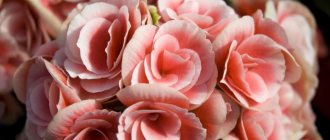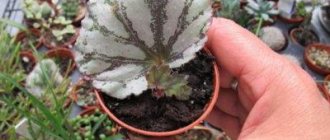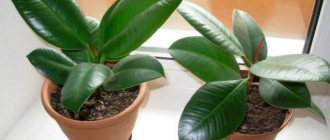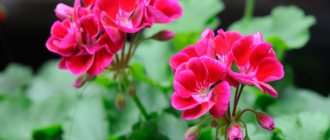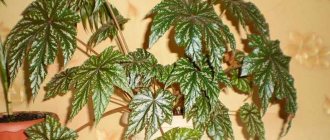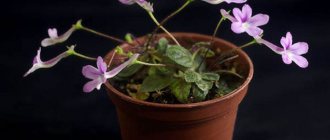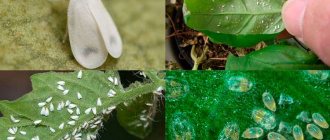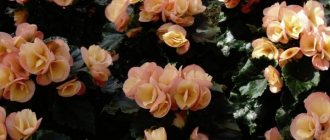Description of the flower
A hybrid species of the Begoniaceae family, obtained by crossing tuberous and Socotrans begonias. The height of the bush reaches 40 cm and is characterized by fleshy stems and glossy leaves in the shape of an asymmetrical heart with jagged edges of a characteristic color (the top is glossy green, the bottom is matte salad green with pronounced veins).
During flowering, the plant is covered with bright inflorescences of rich, rich shades on thin peduncles growing from the axils of the leaves. The diameter of the flower is about 5 cm. The flowering period of Elatior begonia is from the beginning of summer to the end of winter, which is why it received its second name - winter begonia. You can read about other types of flowering begonias and the features of their cultivation in a separate article.
Reference! This hybrid was bred in 1883 by the English gardener Z. Veitch.
Varieties of begonia elatior
The following varieties of begonia elatior are grown in the apartment:
| Variety | Description | Flowers |
| Baladin | It reaches 30 cm, but the peduncles have different lengths, which helps create a multi-tiered effect. The plant has acquired the nickname “bouquet in a pot” and is often purchased for various holidays. | Color – deep red. Flowering occurs 2-3 times a year. |
| Borias | The variety was discovered in England and looks like classic roses. Peduncles multi-tiered. The foliage is glossy. | Color: light pink or coral. The buds are quite large, terry. |
| Grace | The homeland is considered to be Southeast Asia, the height of the bush is up to 35 cm. | Red, they bloom twice a year and do not fade for several months. |
How to propagate at home?
Cuttings
Propagation by cuttings is one of the most popular methods of propagation, as it allows you to preserve all the characteristics of the mother plant and gives quick results. Cuttings of begonia Elatior are carried out in the spring-summer period, when the plant is in the active growing season, and weather conditions contribute to the rapid and effective rooting of shoots.
Some gardeners believe that cuttings rooted in summer will produce too squat, low-growing bushes that bloom too quickly, preventing the plant from fully growing.
Preparation of cuttings
- It is necessary to select healthy, without visible damage, apical cuttings 8–10 cm long, each one must have a pair of leaves and 2–3 axillary buds.
- They should be cut from the mother plant with a sharp, disinfected knife or pruning shears at an angle of 45 degrees.
- It is recommended to air dry the petiole a little, and before rooting, dip its tip in a root formation stimulator.
Another option is also allowed: cut cuttings are left overnight in a Heteroauxin solution.
How to root?
The best option for rooting Elatior begonia is to place the cutting not in soil or water, but directly in vermiculite, perlite or pure sphagnum. All of these substances have some antibacterial properties.
It is better to use a small transparent container as a pot for rooting cuttings : this will make it easier to observe the development of roots and the condition of the soil. You can use ordinary plastic cups for these purposes, but do not forget to make holes in them to drain excess water, and the bottom layer should be drainage and consist of expanded clay or brick chips, pieces of foam.
- The cut and dried petiole is dipped with the tip into water, and then into a root formation stimulator, for example, “Kornevin”.
- Next, the shoot is buried at an angle into moist vermiculite by 2–3 cm. Rooting will be more likely to succeed if the top of the pot is covered with a jar or plastic bag, while not forgetting to open the bag or jar daily to ventilate the seedling and systematically moisten the soil.
- With the appearance of the first roots (in 2 - 2.5 weeks), the “greenhouse” can be removed.
Planting in the soil
As soon as the roots become stronger, the begonia can be planted in individual pots with a diameter of 7–9 cm, which are filled with a substrate consisting of purchased soil, perlite and vermiculite in equal proportions.
The best planting method for young seedlings rooting in the ground is the transshipment method:
- The plant is taken out of the container and, without shaking off the soil clod, is placed in a new pot.
- The top layer of soil near the stem is pressed down with your hands, the plant is watered and put in its place.
- When the plant reaches a height of 12–15 cm, it is necessary to pinch the top leaf to form a decorative crown of the plant.
Attention! In begonia Elatior, the development of flower stalks can be stimulated: the plant receives light for 9 hours, the rest of the time the sprouts are covered with a black bag. This regime must be followed for 10 - 14 days. As a result of such manipulations, flowering can be expected within 2 to 3 months.
We invite you to watch a video about the propagation of Elatior begonia by cuttings and leaves:
Seeds
Since Elatior begonia is a hybrid, it is extremely difficult to propagate it at home. It is not possible to collect seed material on your own. But if you managed to buy seeds in a store, then you can sow them in February - March, so that by the beginning of summer the plant produces its first buds.
A suitable container is a container with holes in the bottom and a drainage layer . It is better to buy soil; it should be watered generously a day before sowing.
- The seeds are evenly distributed over the surface, covered with glass or film on top, not forgetting about daily ventilation of the crops. The required temperature in the room with containers is + 22C – +25C. The place in which the box with seedlings is located should be well lit, but without direct sunlight.
- After the seedlings appear and grow stronger, the coating can be removed.
- When the seedlings have formed 2 - 3 leaves, it is necessary to pick them, planting them 2 - 3 cm from each other.
- After a month or two, re-picking is carried out: the distance between the seedlings should be 5 – 6 cm.
- And only in May, with the establishment of warm weather, young shoots are planted in individual pots.
Read more about propagating ever-flowering begonia by seeds and cuttings in this article.
Reference! Planting plant seedlings from common containers into individual containers is traditionally called planting. In this case, the final part of the taproot must be removed during this planting. This is done in order to stimulate branching of the root system.
Diseases and pests
Diseases
Begonia elatior can develop powdery mildew. In this case, very small light-colored spots form on the surface of its foliage. There is a gradual darkening of the leaves and their drying out. You can treat the bush with a solution of tar soap (20 grams per 1 liter of water) or copper sulfate (2 grams per 1 liter of water). You can also use a solution of a fungicidal drug.
If whitish spots with a slight grayish coating appear on the bush, this means that it is affected by gray rot. The spots gradually darken and become brown and moist. Treat the diseased bush with a solution of Bordeaux mixture (1%) or any fungicidal preparation.
If the plant is affected by bacterial or ring spot, then it must be destroyed and the pot thoroughly disinfected.
Pests
If a false scale insect settles on a begonia, it will begin to weaken and bloom sparingly. The foliage becomes faded and deformed. You can get rid of this pest by treating it with garlic infusion (spray the flower once every 15 days).
To get rid of aphids, the flower is sprayed with a solution of shag infusion (two percent). Moreover, the infusion needs to be kept for two days. You can also use a two to three percent solution of laundry soap. You can also treat the bush with an insecticidal agent.
Possible problems
- Rotting of cuttings . This phenomenon is possible with excessive watering and irrigation. Also, one should not forget about daily ventilation of the “greenhouses” in which the plant is rooted.
- The seeds do not germinate . This is possible if the seed was of poor quality or had been lying around for a long time. It is necessary to check the expiration date of seeds purchased in the store. Dry soil and low room temperature can also cause this phenomenon. The solution is to moisten the soil in the container, raise the temperature to +22C - +25C.
- The shoots are too long and thin . They clearly don't have enough light. The container with seedlings must be moved closer to the light source.
- Slow growth . The seedling lacks nutrients and needs to be fed.
You will find additional information about ever-flowering begonia varieties in separate articles on the pages of our website. Read:
- Basic rules for caring for ever-flowering begonia at home.
- Magnificent double ever-blooming begonia.
Further care
The tropical beauty requires special conditions, it is often subject to stress, and the development process directly depends on the surrounding parameters. To get good results when growing begonias, you should pay attention to the following nuances:
The optimal temperature and humidity conditions in the room should be at +22-26°C, humidity 70%.- Begonia Elatior prefers diffused sunlight.
- Moderate moisture, do not flood the plant with water. You need to water again when the top layer of soil dries well. Do not spray the plant under any circumstances, otherwise this may lead to the development of fungal diseases.
- During the flowering period, it is important to feed the flower with fertilizers high in potassium and phosphorus. During the active growth phase, fertilize with nitrogen minerals, but in moderation.
- In winter, the air temperature should be maintained at no lower than +18°C, with minimal watering.
- As the plant grows, it should be pinched so that the bush has a neat shape and compact size. Remove the top shoots from the crowns. Removing the lower leaves helps to ventilate the root zone of the flower.
- As necessary, you should pick off dried flowers, loosen the soil, spray, remove dust from the foliage, and inspect the plant for pests.
Find out more details about how to care for Elatior begonias so that they will delight you with their flowering even in winter.
Propagating and growing Elatior begonia at home is not so difficult. The main thing is to stick to the basic rules at first, and with experience everything will go like clockwork. And the most beautiful, charming flowers will bloom in your house.
If you find an error, please select a piece of text and press Ctrl+Enter.
